
In spring and summer, all things grow.Especially for babies, regular daily tuina (推拿) health care not only helps to store more yang qi (阳气) in the body but also promotes growth and prevents diseases.Today, we will summarize 21 common pediatric tuina techniques to help everyone care for their babies with more professional skills, ensuring their health and giving mothers peace of mind. Why can pediatric tuina prevent diseases?Pediatric tuina is a health care method based on the holistic view of Traditional Chinese Medicine (TCM).It is guided by theories such as yin-yang (阴阳), five elements (五行), and meridians (经络), using various techniques to stimulate acupuncture points, ensuring smooth meridians and circulation of qi (气) and blood (血), to adjust organ functions, prevent diseases, and promote health.Pediatric tuina emphasizes light, gentle, and steady techniques, focusing on tonifying (补) and reducing (泻) methods, which are effective for common and frequently occurring diseases, especially for digestive disorders.
Why can pediatric tuina prevent diseases?Pediatric tuina is a health care method based on the holistic view of Traditional Chinese Medicine (TCM).It is guided by theories such as yin-yang (阴阳), five elements (五行), and meridians (经络), using various techniques to stimulate acupuncture points, ensuring smooth meridians and circulation of qi (气) and blood (血), to adjust organ functions, prevent diseases, and promote health.Pediatric tuina emphasizes light, gentle, and steady techniques, focusing on tonifying (补) and reducing (泻) methods, which are effective for common and frequently occurring diseases, especially for digestive disorders. 21 Pediatric Tuina TechniquesTo Help Babies Grow Strong1. Tonify the Spleen Meridian
21 Pediatric Tuina TechniquesTo Help Babies Grow Strong1. Tonify the Spleen Meridian Location:The Spleen Meridian is located on the distal phalanx of the thumb, on the radial side, forming a line from the tip to the base of the thumb.Function:Strengthens the spleen and stomach, tonifies qi and blood, clears heat and dampness, transforms phlegm and stops vomiting.Indications:1. Treats digestive issues caused by spleen and stomach deficiency, such as indigestion, poor appetite, and muscle wasting.2. Damp-heat conditions, skin yellowing, nausea, vomiting, diarrhea, dysentery, etc.;3. Treats food stagnation, stomach distension, acid reflux, and vomiting due to spleen and stomach disharmony;4. For children with weak constitution and insufficient righteous qi, this point can be used during febrile diseases.Technique:1. One hand flexes the child’s thumb, while the other hand pushes along the radial edge from the tip to the base of the thumb, or rotates the distal phalanx of the thumb, called tonifying the Spleen Meridian.2. Push from the base to the tip of the thumb, called clearing the Spleen Meridian.3. Both tonifying and clearing the Spleen Meridian are collectively referred to as pushing the Spleen Meridian, with back-and-forth pushing being called even tonifying and reducing, known as clearing and tonifying the Spleen Meridian.Precautions:Children with weak spleen and stomach should primarily use tonifying and reducing techniques; clearing methods should only be used for those with strong bodies and excess conditions.2. Clockwise Eight Trigrams
Location:The Spleen Meridian is located on the distal phalanx of the thumb, on the radial side, forming a line from the tip to the base of the thumb.Function:Strengthens the spleen and stomach, tonifies qi and blood, clears heat and dampness, transforms phlegm and stops vomiting.Indications:1. Treats digestive issues caused by spleen and stomach deficiency, such as indigestion, poor appetite, and muscle wasting.2. Damp-heat conditions, skin yellowing, nausea, vomiting, diarrhea, dysentery, etc.;3. Treats food stagnation, stomach distension, acid reflux, and vomiting due to spleen and stomach disharmony;4. For children with weak constitution and insufficient righteous qi, this point can be used during febrile diseases.Technique:1. One hand flexes the child’s thumb, while the other hand pushes along the radial edge from the tip to the base of the thumb, or rotates the distal phalanx of the thumb, called tonifying the Spleen Meridian.2. Push from the base to the tip of the thumb, called clearing the Spleen Meridian.3. Both tonifying and clearing the Spleen Meridian are collectively referred to as pushing the Spleen Meridian, with back-and-forth pushing being called even tonifying and reducing, known as clearing and tonifying the Spleen Meridian.Precautions:Children with weak spleen and stomach should primarily use tonifying and reducing techniques; clearing methods should only be used for those with strong bodies and excess conditions.2. Clockwise Eight Trigrams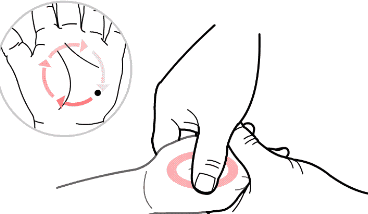 Location:On the palm, with the center at the Laogong (劳宫) point, draw a circle with a radius from the center to the junction of the inner 2/3 and outer 1/3 of the middle finger’s transverse line.Function:Clockwise movement treats cold, opens the chest, and harmonizes the five organs; counterclockwise movement treats heat, descends stomach qi, and eliminates food stagnation.Main indications include cough, phlegm asthma, chest tightness, hiccups, vomiting, diarrhea, and poor appetite.Technique:The practitioner uses the right index and middle fingers to pinch the child’s thumb, then uses the thumb to rotate from the Qian (乾) palace to the Dui (兑) palace for one cycle, called clockwise inner Eight Trigrams or right-running inner Eight Trigrams; if rotating counterclockwise from the Gen (艮) palace to the Zhen (震) palace, this is called counterclockwise inner Eight Trigrams.Additionally, in clinical applications, specific diseases can be addressed by performing clockwise or counterclockwise rubbing based on the corresponding relationships of the Eight Trigrams and the organs. Perform 100-300 times.Note: During the Eight Trigrams operation, avoid the “Li” (离) palace of the baby’s palm, as it connects to the heart, and excessive massage may harm the baby’s heart.
Location:On the palm, with the center at the Laogong (劳宫) point, draw a circle with a radius from the center to the junction of the inner 2/3 and outer 1/3 of the middle finger’s transverse line.Function:Clockwise movement treats cold, opens the chest, and harmonizes the five organs; counterclockwise movement treats heat, descends stomach qi, and eliminates food stagnation.Main indications include cough, phlegm asthma, chest tightness, hiccups, vomiting, diarrhea, and poor appetite.Technique:The practitioner uses the right index and middle fingers to pinch the child’s thumb, then uses the thumb to rotate from the Qian (乾) palace to the Dui (兑) palace for one cycle, called clockwise inner Eight Trigrams or right-running inner Eight Trigrams; if rotating counterclockwise from the Gen (艮) palace to the Zhen (震) palace, this is called counterclockwise inner Eight Trigrams.Additionally, in clinical applications, specific diseases can be addressed by performing clockwise or counterclockwise rubbing based on the corresponding relationships of the Eight Trigrams and the organs. Perform 100-300 times.Note: During the Eight Trigrams operation, avoid the “Li” (离) palace of the baby’s palm, as it connects to the heart, and excessive massage may harm the baby’s heart.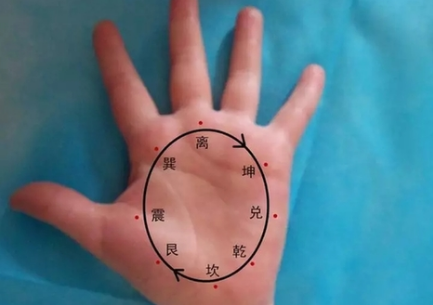 3. Pinch the Five Finger Joints
3. Pinch the Five Finger Joints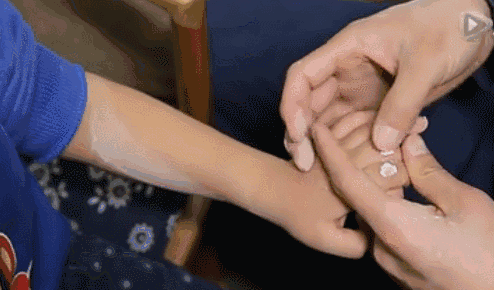 Location:On the back of the hand, at the first interphalangeal joint of the five fingers.Function:Calms the mind, dispels wind and phlegm, and opens the orifices.Main indications include restlessness, convulsions, chest tightness, phlegm asthma, cough, wind phlegm, drooling, abdominal pain, poor circulation, and difficulty breathing.Technique:Generally, use pinching and rubbing techniques.Pinching: Use the thumb nail to pinch 3-5 times, called pinching the five finger joints.Rubbing: Use the thumb and index finger to rub 30-50 times, called rubbing the five finger joints.Twisting: Use the thumb and index finger to twist the finger joints 30 times. This can treat joint swelling and pain caused by sprains and strains, and frequent rubbing of the five finger joints is beneficial for children’s intellectual development and can be used for pediatric health care.Bending and stretching: Use the thumb and index finger to pinch the finger joints and perform bending and stretching activities about 3-5 times.4. Rub Yongquan
Location:On the back of the hand, at the first interphalangeal joint of the five fingers.Function:Calms the mind, dispels wind and phlegm, and opens the orifices.Main indications include restlessness, convulsions, chest tightness, phlegm asthma, cough, wind phlegm, drooling, abdominal pain, poor circulation, and difficulty breathing.Technique:Generally, use pinching and rubbing techniques.Pinching: Use the thumb nail to pinch 3-5 times, called pinching the five finger joints.Rubbing: Use the thumb and index finger to rub 30-50 times, called rubbing the five finger joints.Twisting: Use the thumb and index finger to twist the finger joints 30 times. This can treat joint swelling and pain caused by sprains and strains, and frequent rubbing of the five finger joints is beneficial for children’s intellectual development and can be used for pediatric health care.Bending and stretching: Use the thumb and index finger to pinch the finger joints and perform bending and stretching activities about 3-5 times.4. Rub Yongquan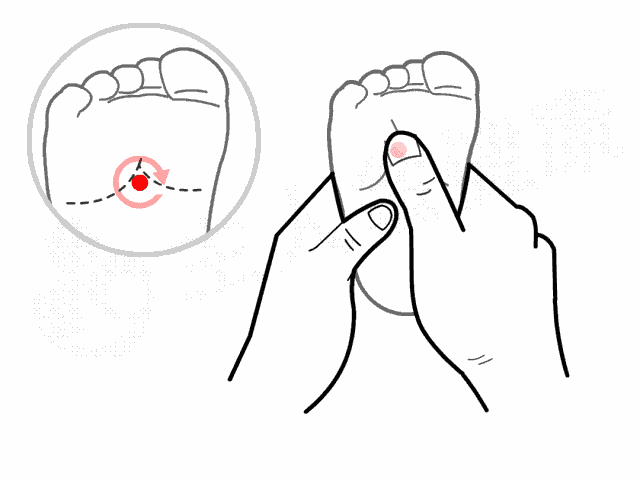 Location:Located on the sole of the foot, in the depression at the front of the foot when curled, approximately at the junction of the anterior 1/3 and posterior 2/3 of the line connecting the second and third toe and the heel.Function:The Yongquan (涌泉) point is one of the commonly used points of the Kidney Meridian (肾经), primarily treating lung-related diseases, constipation, urinary difficulties, and ben tun qi (奔豚气).Technique:Place the tip of the thumb or index finger on the Yongquan point and press and rub back and forth, ideally 100 times daily.5. Pound the Little Heavenly Heart
Location:Located on the sole of the foot, in the depression at the front of the foot when curled, approximately at the junction of the anterior 1/3 and posterior 2/3 of the line connecting the second and third toe and the heel.Function:The Yongquan (涌泉) point is one of the commonly used points of the Kidney Meridian (肾经), primarily treating lung-related diseases, constipation, urinary difficulties, and ben tun qi (奔豚气).Technique:Place the tip of the thumb or index finger on the Yongquan point and press and rub back and forth, ideally 100 times daily.5. Pound the Little Heavenly Heart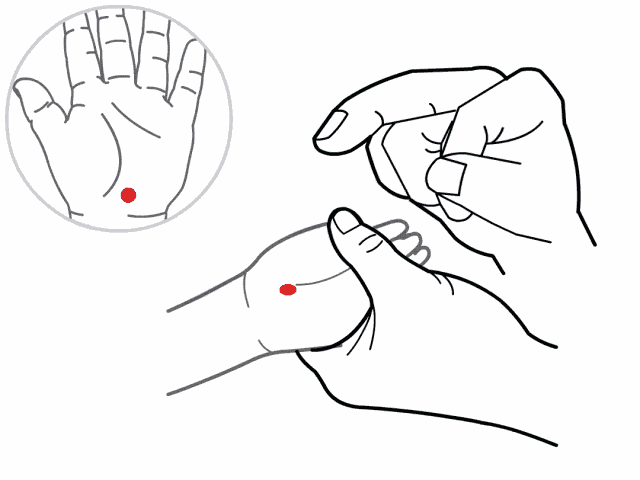 Location:At the junction of the major and minor fish mounds on the palm.Function:Opens all meridians, clears heart fire, induces sweating to expel pathogens, calms the mind, stops fright, and promotes sleep.Technique:Rub clockwise for 3-10 minutes.6. Soothe the Liver Meridian, Clear the Lung Meridian
Location:At the junction of the major and minor fish mounds on the palm.Function:Opens all meridians, clears heart fire, induces sweating to expel pathogens, calms the mind, stops fright, and promotes sleep.Technique:Rub clockwise for 3-10 minutes.6. Soothe the Liver Meridian, Clear the Lung Meridian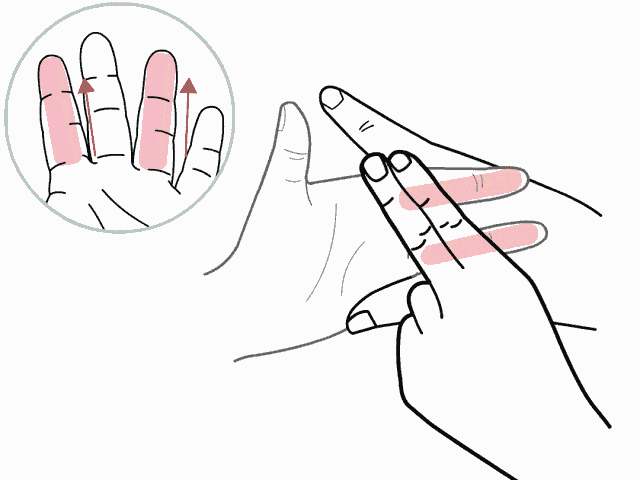 Location:The Liver Meridian points are located on the distal phalanx of the index finger, while the Lung Meridian points are primarily on the distal phalanx of the ring finger.Function:Used to prevent respiratory infections.Technique:Use the pads of the index and middle fingers to push along the palmar surface of the child’s left index and ring fingers from the base to the tip.7. Clockwise Abdominal Massage
Location:The Liver Meridian points are located on the distal phalanx of the index finger, while the Lung Meridian points are primarily on the distal phalanx of the ring finger.Function:Used to prevent respiratory infections.Technique:Use the pads of the index and middle fingers to push along the palmar surface of the child’s left index and ring fingers from the base to the tip.7. Clockwise Abdominal Massage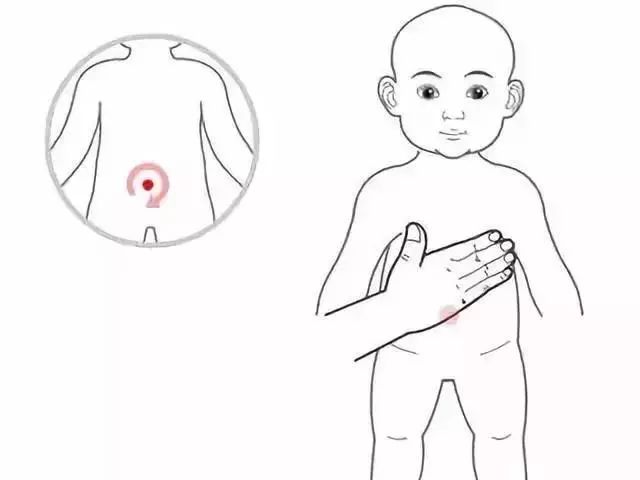 Location:Centered around the navel, in a circular motion.Function:Main indications include constipation, food accumulation, internal heat, bad breath, irritability, and thick yellow tongue coating.Technique:Massage in a clockwise direction around the navel for 5-10 minutes.8. Grab Fengchi
Location:Centered around the navel, in a circular motion.Function:Main indications include constipation, food accumulation, internal heat, bad breath, irritability, and thick yellow tongue coating.Technique:Massage in a clockwise direction around the navel for 5-10 minutes.8. Grab Fengchi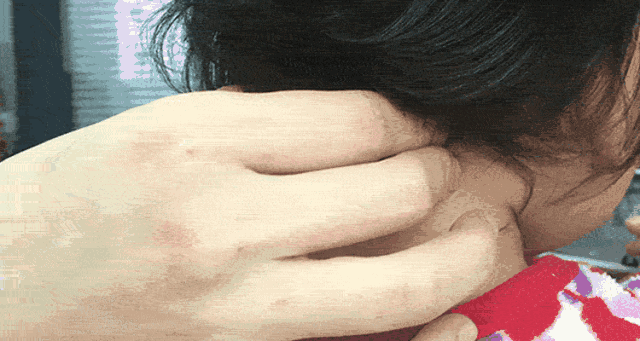 Location:Between the sternocleidomastoid and trapezius muscles, 0.5 inches above the hairline.Function:Induces sweating for colds, alleviates headaches, and reduces fever.Technique:The practitioner uses the thumb and index finger to pinch and lift both Fengchi points simultaneously, called grabbing Fengchi. Repeat 5-10 times. Rubbing from top to bottom with the thumb is also acceptable.9. Retreat the Six Fu Organs
Location:Between the sternocleidomastoid and trapezius muscles, 0.5 inches above the hairline.Function:Induces sweating for colds, alleviates headaches, and reduces fever.Technique:The practitioner uses the thumb and index finger to pinch and lift both Fengchi points simultaneously, called grabbing Fengchi. Repeat 5-10 times. Rubbing from top to bottom with the thumb is also acceptable.9. Retreat the Six Fu Organs Location:On the ulnar side of the forearm, in a straight line from the elbow crease to the wrist crease.Function:Cools the blood, stops bleeding, detoxifies, and reduces heat caused by excess fire, inflammation, and swelling.This point is cold in nature and should be avoided in cases of deficiency-cold.Technique:Perform centrifugal pushing 100-300 times.10. Pinch and Squeeze Dazhui
Location:On the ulnar side of the forearm, in a straight line from the elbow crease to the wrist crease.Function:Cools the blood, stops bleeding, detoxifies, and reduces heat caused by excess fire, inflammation, and swelling.This point is cold in nature and should be avoided in cases of deficiency-cold.Technique:Perform centrifugal pushing 100-300 times.10. Pinch and Squeeze Dazhui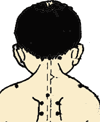 Location:Located in the cervical spine area, between the 7th cervical vertebra and the 1st thoracic vertebra.Function:Clears heat and resolves exterior pathogens, opens the meridians. Main indications include fever without sweating, colds, sore throat, neck stiffness, cough, whooping cough, and asthma.Technique:Use the tip of the thumb or middle finger to rub this point, called rubbing Dazhui. Use both thumbs and index fingers to pinch the skin and squeeze towards the point, performing 30-50 times.11. Separate Yin and Yang of the Hands
Location:Located in the cervical spine area, between the 7th cervical vertebra and the 1st thoracic vertebra.Function:Clears heat and resolves exterior pathogens, opens the meridians. Main indications include fever without sweating, colds, sore throat, neck stiffness, cough, whooping cough, and asthma.Technique:Use the tip of the thumb or middle finger to rub this point, called rubbing Dazhui. Use both thumbs and index fingers to pinch the skin and squeeze towards the point, performing 30-50 times.11. Separate Yin and Yang of the Hands Location:At the base of the palm, starting from the Little Heavenly Heart point, push outward to separate the Yin and Yang points. Pushing towards the thumb side is for Yang points, while pushing towards the little finger side is for Yin points.Function:Balances Yin and Yang, eliminates food stagnation, transforms phlegm, and aids digestion. Pushing Yang points is suitable for those with excess cold in the body; pushing Yin points is suitable for those with excess heat.Technique:Separate Yin and Yang by using both thumbs to push outward from the Little Heavenly Heart point for 2-5 minutes.① For Yang points: Push from the Little Heavenly Heart point towards the major fish mound for 2-5 minutes.② For Yin points: Push from the Little Heavenly Heart point towards the minor fish mound for 2-5 minutes.12. Clear the Large Intestine
Location:At the base of the palm, starting from the Little Heavenly Heart point, push outward to separate the Yin and Yang points. Pushing towards the thumb side is for Yang points, while pushing towards the little finger side is for Yin points.Function:Balances Yin and Yang, eliminates food stagnation, transforms phlegm, and aids digestion. Pushing Yang points is suitable for those with excess cold in the body; pushing Yin points is suitable for those with excess heat.Technique:Separate Yin and Yang by using both thumbs to push outward from the Little Heavenly Heart point for 2-5 minutes.① For Yang points: Push from the Little Heavenly Heart point towards the major fish mound for 2-5 minutes.② For Yin points: Push from the Little Heavenly Heart point towards the minor fish mound for 2-5 minutes.12. Clear the Large Intestine Location:On the radial side of the index finger, in a straight line from the tip of the index finger to the space between the thumb and index finger.Function:Stops diarrhea and clears heat from the large intestine.Technique:Push back and forth (clearing method) for 3-15 minutes for mild intestinal heat; perform centrifugal pushing (reducing method) for 3-15 minutes for significant intestinal heat.13. Pinch the Four Horizontal Lines
Location:On the radial side of the index finger, in a straight line from the tip of the index finger to the space between the thumb and index finger.Function:Stops diarrhea and clears heat from the large intestine.Technique:Push back and forth (clearing method) for 3-15 minutes for mild intestinal heat; perform centrifugal pushing (reducing method) for 3-15 minutes for significant intestinal heat.13. Pinch the Four Horizontal Lines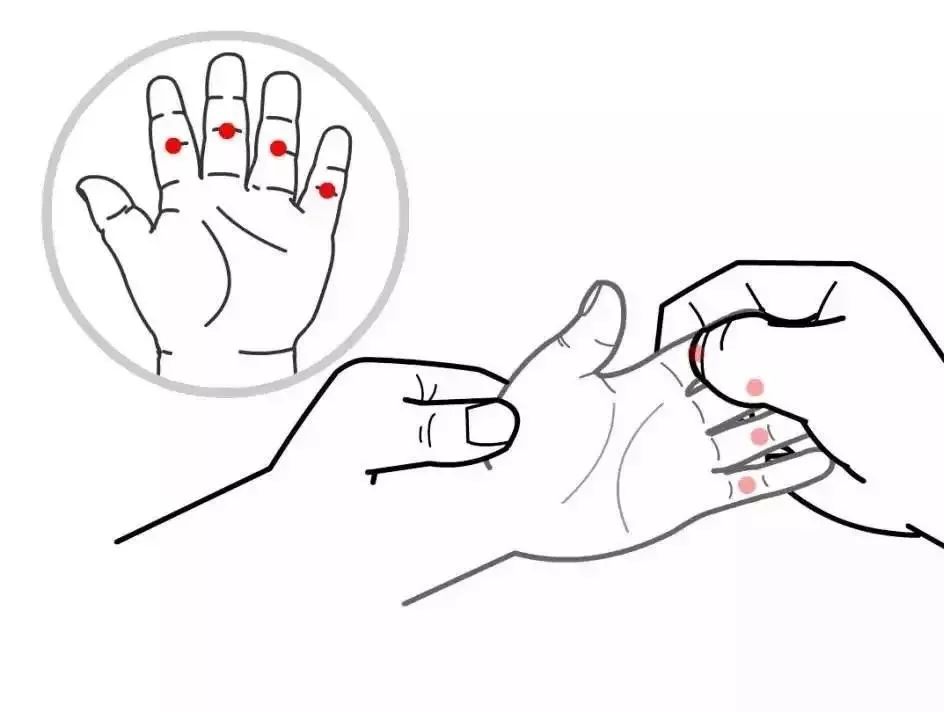 Location:On the palmar side at the transverse lines of the proximal interphalangeal joints of the index, middle, ring, and little fingers (also known as the four horizontal lines).Function:Used for pediatric abdominal distension, malnutrition, and indigestion; pushing the four horizontal lines is often used to treat indigestion and malnutrition, and can be combined with tonifying the Spleen Meridian and rubbing the Zhongwan point.Technique:① Gather the four fingers and push from the index finger’s transverse line to the little finger’s transverse line, called pushing the four horizontal lines;② Use the thumb nail to pinch the transverse lines of the index, middle, ring, and little fingers, called pinching the four horizontal lines.Push 100-300 times; pinch 5 times.14. Rub the Lung Shu
Location:On the palmar side at the transverse lines of the proximal interphalangeal joints of the index, middle, ring, and little fingers (also known as the four horizontal lines).Function:Used for pediatric abdominal distension, malnutrition, and indigestion; pushing the four horizontal lines is often used to treat indigestion and malnutrition, and can be combined with tonifying the Spleen Meridian and rubbing the Zhongwan point.Technique:① Gather the four fingers and push from the index finger’s transverse line to the little finger’s transverse line, called pushing the four horizontal lines;② Use the thumb nail to pinch the transverse lines of the index, middle, ring, and little fingers, called pinching the four horizontal lines.Push 100-300 times; pinch 5 times.14. Rub the Lung Shu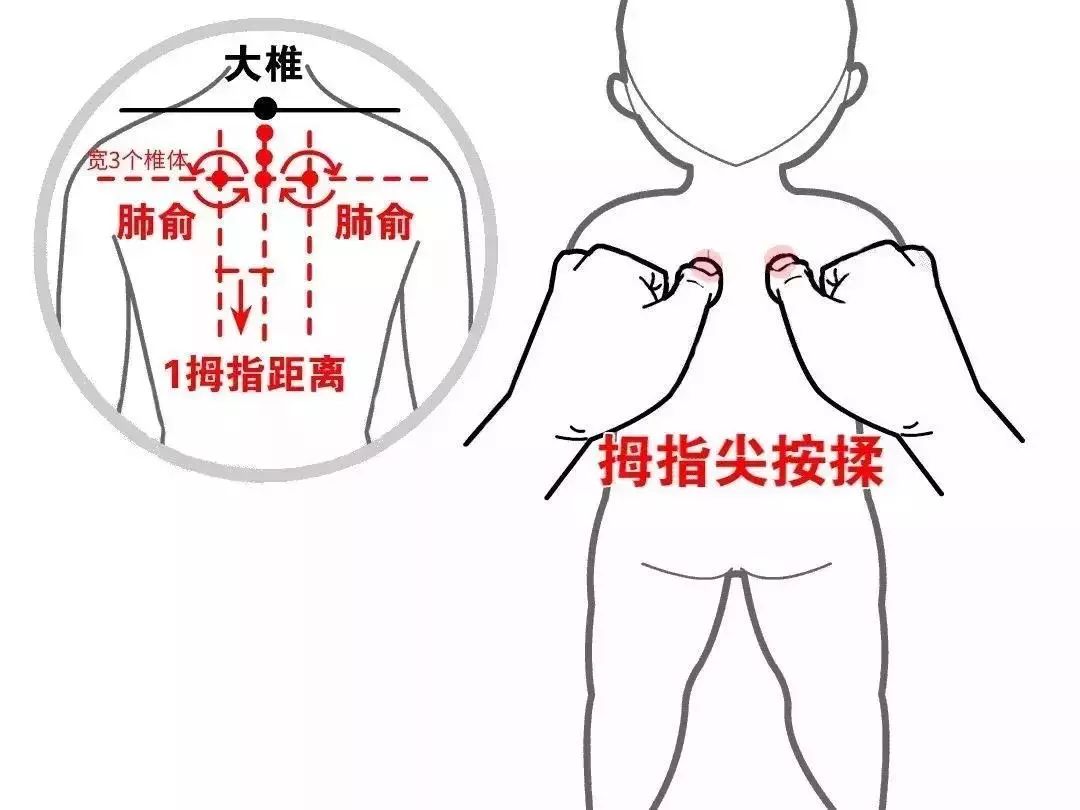 Location:The Lung Shu point is located on the back, below the 3rd thoracic vertebra, 1.5 inches (two finger widths) lateral to the spine.Function:1. Stops phlegm and alleviates cough, asthma, hemoptysis, and night sweats;2. Alleviates bronchial asthma, bronchitis, tuberculosis, pneumonia, etc.;3. Alleviates skin itching.Technique:When coughing up phlegm, exhale while pressing the Lung Shu point strongly for 6 seconds, repeating three times to feel the foreign body sensation in the throat disappear. Children should not press too hard and should increase the number of repetitions.15. Push the Seven Vertebrae Down
Location:The Lung Shu point is located on the back, below the 3rd thoracic vertebra, 1.5 inches (two finger widths) lateral to the spine.Function:1. Stops phlegm and alleviates cough, asthma, hemoptysis, and night sweats;2. Alleviates bronchial asthma, bronchitis, tuberculosis, pneumonia, etc.;3. Alleviates skin itching.Technique:When coughing up phlegm, exhale while pressing the Lung Shu point strongly for 6 seconds, repeating three times to feel the foreign body sensation in the throat disappear. Children should not press too hard and should increase the number of repetitions.15. Push the Seven Vertebrae Down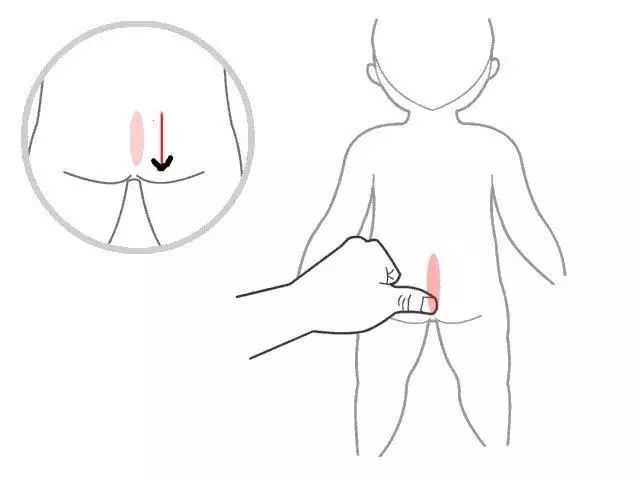 Location:Located on the midline of the back, from the lowest point of the waist to the coccyx.Function:Regulates the spleen and stomach, and adjusts bowel movements.Technique:Have the baby lie face down, and the practitioner uses the thumb or three middle fingers to push from the lowest point of the waist to the coccyx, about once per second, for a total of 2 minutes, 100-300 times.16. Tuina the Jianjing Point
Location:Located on the midline of the back, from the lowest point of the waist to the coccyx.Function:Regulates the spleen and stomach, and adjusts bowel movements.Technique:Have the baby lie face down, and the practitioner uses the thumb or three middle fingers to push from the lowest point of the waist to the coccyx, about once per second, for a total of 2 minutes, 100-300 times.16. Tuina the Jianjing Point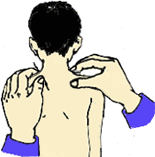 Location: The point is located below the shoulder, at the midpoint of the line connecting the Dazhui and the acromion.Function: Promotes the circulation of qi and blood, induces sweating, and resolves exterior pathogens. Often used for preventing and treating colds, convulsions, and upper limb movement restrictions.Technique: Use both thumbs and index fingers to pinch the large muscle on the shoulder, about 5-10 times.17. Separate Yin and Yang of the Abdomen
Location: The point is located below the shoulder, at the midpoint of the line connecting the Dazhui and the acromion.Function: Promotes the circulation of qi and blood, induces sweating, and resolves exterior pathogens. Often used for preventing and treating colds, convulsions, and upper limb movement restrictions.Technique: Use both thumbs and index fingers to pinch the large muscle on the shoulder, about 5-10 times.17. Separate Yin and Yang of the Abdomen Location:The abdominal Yin and Yang points are located at the Zhongwan point and the soft flesh below the ribs.Function:Can strengthen the spleen and stomach, regulate qi, and aid digestion. Main indications include abdominal pain, distension, and borborygmi. Clockwise abdominal massage can relieve constipation, while counterclockwise can stop diarrhea.Technique:Push along the edge of the rib cage or from the Zhongwan point to the navel, pushing outward, called separating the Yin and Yang of the abdomen; rubbing with the palm or four fingers is called abdominal massage.18. Horizontal Rubbing of the Small Horizontal Lines
Location:The abdominal Yin and Yang points are located at the Zhongwan point and the soft flesh below the ribs.Function:Can strengthen the spleen and stomach, regulate qi, and aid digestion. Main indications include abdominal pain, distension, and borborygmi. Clockwise abdominal massage can relieve constipation, while counterclockwise can stop diarrhea.Technique:Push along the edge of the rib cage or from the Zhongwan point to the navel, pushing outward, called separating the Yin and Yang of the abdomen; rubbing with the palm or four fingers is called abdominal massage.18. Horizontal Rubbing of the Small Horizontal Lines Location:The small horizontal lines are located at the transverse lines of the metacarpophalangeal joints of the index, middle, ring, and little fingers.Function:Opens the chest, disperses stagnation, and transforms phlegm. Mainly used for heat accumulation in the spleen and stomach, reducing fever, relieving distension, dispersing nodules, oral ulcers, chapped lips, and irritability.Technique:1. Pinching and Rubbing: Use the thumb nail to pinch and rub each point (can pinch once and rub three times), called pinching and rubbing the small horizontal lines.2. Pushing: Use the thumb to push each point vertically up and down, or have the child gather four fingers and push horizontally back and forth, called pushing the small horizontal lines.19. Rub the Banmen Point
Location:The small horizontal lines are located at the transverse lines of the metacarpophalangeal joints of the index, middle, ring, and little fingers.Function:Opens the chest, disperses stagnation, and transforms phlegm. Mainly used for heat accumulation in the spleen and stomach, reducing fever, relieving distension, dispersing nodules, oral ulcers, chapped lips, and irritability.Technique:1. Pinching and Rubbing: Use the thumb nail to pinch and rub each point (can pinch once and rub three times), called pinching and rubbing the small horizontal lines.2. Pushing: Use the thumb to push each point vertically up and down, or have the child gather four fingers and push horizontally back and forth, called pushing the small horizontal lines.19. Rub the Banmen Point Location:Located at the major fish mound below the base of the thumb.Function:Strengthens the spleen and stomach, aids digestion. Main indications include pediatric diarrhea, abdominal distension, belching, poor appetite, vomiting, nausea, indigestion, anorexia, and night sweats.Technique:Place the tip of the thumb at the midpoint of the major fish mound, pressing clockwise for 100 times, then counterclockwise for 100 times.20. Rub Zusanli
Location:Located at the major fish mound below the base of the thumb.Function:Strengthens the spleen and stomach, aids digestion. Main indications include pediatric diarrhea, abdominal distension, belching, poor appetite, vomiting, nausea, indigestion, anorexia, and night sweats.Technique:Place the tip of the thumb at the midpoint of the major fish mound, pressing clockwise for 100 times, then counterclockwise for 100 times.20. Rub Zusanli Location:On the outer side of the calf, 3 inches below the knee, on the line connecting the knee and the ankle.Function:Dries dampness from the spleen and promotes stomach qi.Technique:During the massage, use the tips of both thumbs to press on the Zusanli points on both legs, maintaining the position of the fingertips while gradually increasing the pressure, applying continuous and even pressure.21. Clear the Tianhe Water
Location:On the outer side of the calf, 3 inches below the knee, on the line connecting the knee and the ankle.Function:Dries dampness from the spleen and promotes stomach qi.Technique:During the massage, use the tips of both thumbs to press on the Zusanli points on both legs, maintaining the position of the fingertips while gradually increasing the pressure, applying continuous and even pressure.21. Clear the Tianhe Water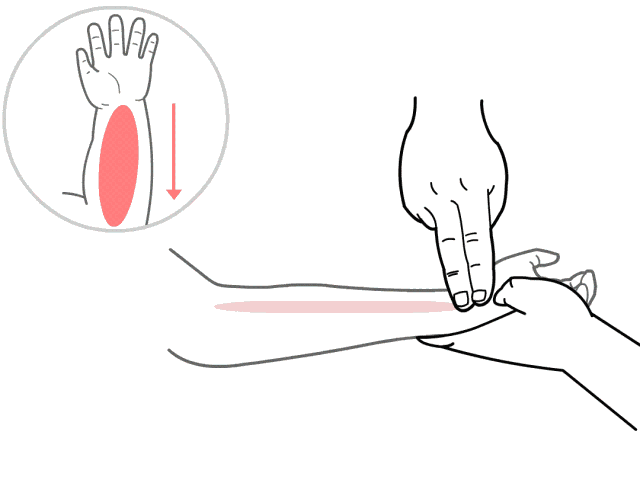 Location:On the palmar side of the forearm, in a straight line from the midpoint of the wrist crease to the midpoint of the elbow crease.Function:Drains heart fire, calms the mind, relieves irritability, promotes urination, transforms heat phlegm, and reduces fever caused by heart fire. This point is cold in nature and should be avoided in cases of deficiency-cold.Technique:Push towards the center from the wrist crease to the elbow crease for 1-10 minutes.
Location:On the palmar side of the forearm, in a straight line from the midpoint of the wrist crease to the midpoint of the elbow crease.Function:Drains heart fire, calms the mind, relieves irritability, promotes urination, transforms heat phlegm, and reduces fever caused by heart fire. This point is cold in nature and should be avoided in cases of deficiency-cold.Technique:Push towards the center from the wrist crease to the elbow crease for 1-10 minutes. Do not perform tuina on babies under the following conditions:After learning these 21 tuina techniques, we cannot immediately apply them to babies. Before performing tuina, it is essential to confirm that the baby does not have the following five conditions:1. Skin burns, scalds, abrasions, cracks, or scabies; local tuina is not suitable.2. Certain acute infectious diseases, such as cellulitis, bone tuberculosis, osteomyelitis, erysipelas, etc., are not suitable for tuina.3. Various malignant tumors, trauma, fractures, dislocations, etc., are not suitable for tuina.4. Certain acute infectious diseases, such as acute hepatitis, tuberculosis, etc., are not suitable for tuina.5. Severe heart disease, liver disease, and mental illness patients should be cautious with tuina.
Do not perform tuina on babies under the following conditions:After learning these 21 tuina techniques, we cannot immediately apply them to babies. Before performing tuina, it is essential to confirm that the baby does not have the following five conditions:1. Skin burns, scalds, abrasions, cracks, or scabies; local tuina is not suitable.2. Certain acute infectious diseases, such as cellulitis, bone tuberculosis, osteomyelitis, erysipelas, etc., are not suitable for tuina.3. Various malignant tumors, trauma, fractures, dislocations, etc., are not suitable for tuina.4. Certain acute infectious diseases, such as acute hepatitis, tuberculosis, etc., are not suitable for tuina.5. Severe heart disease, liver disease, and mental illness patients should be cautious with tuina. Pay attention to the lightness of the technique!Once it is confirmed that the baby can undergo tuina massage, during the actual massage process, practitioners must pay attention to the strength of the technique, especially in the following four aspects:1. The strength of tuina techniques varies; 2. Different children have different tolerances to techniques; 3. Different diseases require different strengths of techniques; 4. As treatment progresses and the condition changes, even for the same child, the strength of the technique should vary. This ensures that the tuina techniques are “appropriate and not excessive.” Additionally, it is important to remind practitioners that the pathological characteristics of pediatric diseases make children susceptible to rapid onset and transmission, and improper or untimely treatment can affect the prognosis of the disease. Therefore, before performing tuina on babies, professional training and repeated practice are essential.This is both an obligation and a responsibility for our reputation.Friends, let’s learn together!Discussion TimeWhat health care techniques do you usually use?Feel free to leave comments for discussion!—END—
Pay attention to the lightness of the technique!Once it is confirmed that the baby can undergo tuina massage, during the actual massage process, practitioners must pay attention to the strength of the technique, especially in the following four aspects:1. The strength of tuina techniques varies; 2. Different children have different tolerances to techniques; 3. Different diseases require different strengths of techniques; 4. As treatment progresses and the condition changes, even for the same child, the strength of the technique should vary. This ensures that the tuina techniques are “appropriate and not excessive.” Additionally, it is important to remind practitioners that the pathological characteristics of pediatric diseases make children susceptible to rapid onset and transmission, and improper or untimely treatment can affect the prognosis of the disease. Therefore, before performing tuina on babies, professional training and repeated practice are essential.This is both an obligation and a responsibility for our reputation.Friends, let’s learn together!Discussion TimeWhat health care techniques do you usually use?Feel free to leave comments for discussion!—END—
For more valuable content, click to follow and learn more!
If you find this useful, please “share” it with your friends!

